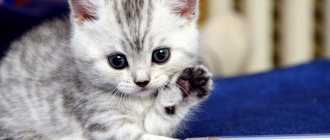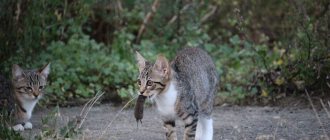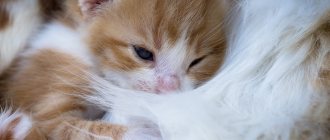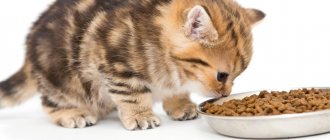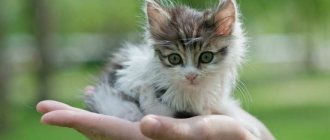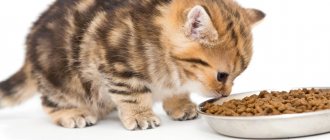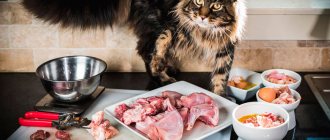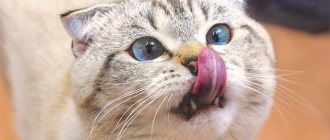All representatives of the Siamese-Oriental group have a fit, graceful figure and a characteristic acromelanic color. They are also known for being picky about food and prone to allergic reactions. It is almost impossible to force a cat to change its eating habits. Therefore, you can feed Siamese cats only with foods that they themselves approve of.
Choosing a place and utensils for feeding a Siamese kitten at home
Asian cats combine two principles - they are playful and active, but secretive and sometimes aggressive. Therefore, in the process of organizing living conditions for a Siamese kitten, it is necessary to take into account the pet’s character traits.
- The place for feeding the kitten should be isolated, but at the same time located within the kitchen.
- If there are other animals in the apartment, you should create conditions under which “competitors” will not disturb the kitten while eating.
- Dishes must meet hygienic and sanitary requirements.
These items are universal for feeding all domestic cats, but the capriciousness of Oriental breeds requires special attention to be paid to food bowls and drinking bowls.
Dishes for kittens and adult cats are made from plastic, metal, glass or ceramics.
- Cheap polymers should be discarded immediately. When exposed to a humid, warm environment, they release harmful substances. Microcracks form on the surface of the dishes, which are difficult to clean. The process of reproduction of pathogenic bacteria begins, which creates health problems in the Siamese kitten. The cost of high-quality plastic cannot be called budget.
- Metal utensils must be coated with an antibacterial coating layer, which prevents chemical reactions upon contact with food. Old stainless steel or aluminum bowls are not suitable for feeding animals.
- Heat-resistant glass and ceramics are excellent materials with a continuous, safe structure. They are practical, easy to clean from food residues, and have good stability.
To properly feed a Siamese cat, you will have to choose a “kitchen set” of a certain size. The dish should be wide, shallow, without recesses in the center of the bottom.
Manufacturers supply pet bowls with a special rubber gasket on the bottom, which prevents slipping on the surface. If we are talking about ordinary saucers, you can glue such a part yourself. You just need to make sure the plate is level and stable.
Another important element in organizing feeding at home is a drinking bowl. It is necessary to provide the kitten with free access to fresh water:
- Siamese cats are attracted to large containers - it is advisable to pour water into large bowls.
- You can place several drinking bowls in the room.
- Some kittens love to drink tap water - you need to give them this opportunity.
It is not recommended to give preference to combined containers, where one part is for food and the other is for water. Kittens are not particularly careful when eating, so pieces of food easily fall into the water and pollute it.
External features of the Thai cat
Many people confuse the Thai and Siamese cats. This is not surprising, because fluffies are very similar to each other. However, there are some differences that will help you determine the breed with maximum probability. For example, Thai cats have a more massive build and strong limbs.
In addition, it is also important to study other features of the appearance of Thais
| Breed name | Thai cat |
| Time of origin | 1990 |
| Country of origin | Siam (today Thailand) |
| Lifespan | 10-14 years |
| Average weight | 4-6 kg (as an adult) |
| Average height | 28-30 cm |
| Cost of kittens | 200-500 dollars |
Wool
Thai kittens belong to the short-haired category of pets. Their coat is soft and silky. Animals have no undercoat.
Color
There are several color options for Thai cats. However, they are all united by the color point type, when the paws, tail and muzzle have a darker shade compared to other parts of the body. Today, the following wool color options are distinguished: chocolate, lilac, blue, caramel, gray-brown, cinnamon, fawn, red, beige, brown.
Head
It has a round shape without sharp corners. The forehead is slightly convex, the cheeks are round and pronounced. The nose is straight and of medium length.
Ears
They are medium in size, wide at the base and slightly rounded towards the tips. Located widely spaced from each other.
Eyes
Thai cats have beautiful, large, almond-shaped eyes. Since childhood, they have been slightly slanted; the shade can vary from soft blue to dark blue. At the same time, a more saturated, deep eye color is valued much higher, and an animal’s eyes that are too round or too slanted exclude it from the breed standards.
Tail
It is slightly wide at the base, but becomes sharper and narrower towards the tip. The length is proportional to the size of the animal's body.
Body
Thai cats are distinguished by a rather dense, muscular body with a broad chest. At the same time, the animals do not look massive, and their limbs are of medium length. The paws themselves are round in shape and small in size.
Natural diet for a Siamese kitten at home
Depending on the type of feeding, the diet of Siamese kittens can consist of natural or industrial products. Each type of menu has its own pros and cons, and in terms of useful properties, both options are considered to be equivalent.
Preparing natural food at home takes time, and the owner has to independently calculate the size and calorie content of portions. But the advantage of this type of feeding provides absolute control over the quality of the feed and the ability to quickly respond to changes in the animal’s body.
What foods should you give your kitten?
Siamese cats eat almost all foods allowed for representatives of other breeds. Approximately 90-95% of the diet is occupied by the main component of the cat's menu - high-calorie protein food.
- meat – lean beef, rabbit, chicken, turkey;
- fish (river or sea).
The average amount of protein is found in cereals and cereals, and the minimum is found in vegetables. But the main supplier of this valuable raw material is still meat (offal) and fish.
- fermented milk group - kefir, yogurt, yogurt, cottage cheese, cheese;
- vegetables, fruits, cereals;
- vitamin and mineral supplements.
Regular dry yeast contains a complex of vitamins that have a beneficial effect on the condition of the coat and skin. They are mixed into the kitten's food or fed separately.
Important! For normal development, a Siamese kitten needs to synthesize 22 amino acids. His body independently produces only 12, and the “building material” for the remaining 10 comes with food.
Rules and regulations for preparing natural food for a Siamese kitten at home
In order not to calculate the daily portion and its composition based on the number of individual useful components, you can create an approximate menu for the week.
- Meat and fish products occupy 90-95% of the daily diet. Half of them come from meat, a quarter from osteochondral tissue (except fish) and 10-15% remains for offal (liver, heart).
- About 1/10 of the weight should be left for vegetables and cereals. In nature, kittens do not eat such foods, but receive them in processed form from the stomachs of small rodents.
- Once a week you need to give your pet one chicken or quail egg (the yolk is recommended) raw or boiled.
In addition, you should pay attention to the animal protein content of the feed. Its norm should be at least 25%, fats occupy 5-20%, carbohydrates up to 10% (although their presence is not considered a prerequisite).
At home, vegetables and cereals are usually mixed with meat ingredients. But if a Siamese kitten eats grated raw carrots, then there is no need to limit him in this.
Contrary to popular belief, milk does not benefit adult cats. Starting from 2-3 months of age, it is replaced with kefir, fermented baked milk, yogurt and other fermented milk products. They are given pure or mixed with fruit.
It is preferable to feed Siamese cats raw meat. First, it is placed in the freezer for 3-5 days, then doused with boiling water and finely chopped or grated on a coarse grater. This product retains all useful microelements, but kills pathogenic bacteria and parasites.
Fish is given no more than 2 times a week. River fish must be boiled, but sea fish can be given raw. Bones are removed from any fish to avoid damaging the gastrointestinal tract.
The serving size depends on the weight of the Siamese cat:
- Products for feeding a Siamese kitten are selected according to the formula: baby weight/10;
- by 4-5 months, the portion size is gradually reduced and brought to the weight/5 equation;
- An adult Siamese cat should receive a daily portion of food of 200-250 g.
Important! At home, complex dishes for a natural diet are prepared according to the general rule - add 2-3 parts of meat, offal or fish to one part of vegetables or cereals.
External characteristics
The most striking distinctive feature of the Siamese is the dark pigmentation of the paws, tail and “mask” on the face (acromelanic color) and blue eyes.
- The coat is short and shiny.
- An integral feature of these cats is elegance and grace.
- Marking colors range from black and chocolate to blue and purple. In cold climates their color is richer.
- All kittens are born white and begin to darken at 2-3 weeks, acquiring their final color by the age of one year.
It is difficult to confuse a Siamese cat with another breed. A similar color is practically not found in nature.
When choosing food for your pet or pet, be selective. In this breed, if the diet is incorrect, some quite characteristic diseases or consequences are possible.
Ready-made feed
Commercial foods for Siamese cats are divided into two categories: dry kibble and wet mix.
- Manufacturers take into account the age of the animal. Dry food is available in the form of granules of different sizes - for kittens and adult cats. Canned formula for babies is provided in small packages, one package per feeding.
- There is no need to calculate the calorie content of the menu - manufacturers have provided the presence of nutritious and healthy elements.
- A large assortment of food containing various types of meat, fish, and vegetables.
- A series of special industrial feeds are produced, taking into account the developmental characteristics of cats and their susceptibility to certain diseases.
- Feeding a Siamese cat with industrial food at home does not take much time, unlike a natural diet, when the owner has to prepare each portion of food in advance.
Selection of industrial feed
Ready-made food for Siamese cats is divided into several categories:
- Budget economist. The most common group, attractive only by its low cost. This food contains few natural products, a lot of processing of residual meat and bone ingredients, dyes, preservatives and jelly.
- Premium and super premium classes. They differ from each other in the quality of additives and the composition of vitamin and mineral complexes. The main products are of good quality, which puts both offers in the middle price category.
- Holistics are the most expensive food for Siamese cats. Only high-quality raw materials and safe natural preservatives are used here. Another detail is that cereals and grains are completely or partially absent. This is due to the fact that in the natural environment predators do not feed on them and they are not needed as food.
Having chosen a price category, determine the next criterion - type. It is preferable to give kittens wet food, and closer to the age of one year, they can be switched to dry food.
Most often, cats go through three diets throughout their lives. They start feeding the Siamese kitten with natural homemade food or wet industrial mixtures, at puberty they switch to granules, and in old age they combine both methods.
What not to feed
As is the case with other cats, Siamese are forbidden to eat food from the master's table. The following products are strictly prohibited:
- fish or bird bones (including heads, necks, wings) - can injure the animal’s intestines, get stuck in the throat, cause complete or partial intestinal obstruction;
- sweets, confectionery (especially chocolate) - contain components that provoke the development of severe intoxication of the body;
- fatty dairy products and the same types of meat cause indigestion;
- legumes, pasta - cause indigestion and bloating;
- smoked meats (meat, sausages, sausages, etc.) – overload the animal’s liver and irritate the mucous membranes;
- eggplant – causes food poisoning.
Mixed feeding of Siamese cats at home
The mixed type of feeding, which is recommended for older cats, requires special attention from the owner. To maximize the life of an animal, you need to know how to properly combine types of food at home.
- It is recommended to combine industrial feeds from one manufacturer. They implement a general scheme of nutrient balance, and they will not conflict with each other.
- Experts do not advise combining granules and natural homemade food - in such a scenario, control of calories, proteins and vitamins is generally impossible.
- The same goes for the combination of natural food + industrial canned food.
Important! In passive old age, the size of the daily portion should be reduced so that the Siamese cat does not gain excess weight. This leads to additional stress on internal organs, provokes exacerbation of diseases and shortens life.
Feeding with natural products
If you want to feed your Siamese natural products, then you should make sure that they contain the necessary minerals and vitamins. Many people prefer rabbit meat. If the animal is mischievous and refuses such a delicacy, you can try boiling it and offering it chicken or turkey. Few pets will pass by such a tasty treat.
Meat is the basis, but it must be supplemented with cereals and vegetables . The four-legged animals gobble up buckwheat, rice, oatmeal, polenta, and wheat porridge with appetite. And in order for the food to be rich in healthy ingredients, you should add some grated vegetables to it. It could be carrots, zucchini, pumpkin, cauliflower. You should not overdo it with these products, because vegetables greatly clog the smell of porridge and meat, which repels the Siamese.
Important! When preparing food for your cat, you should not add salt or other spices to it. Animals don't need them.
Algorithm for switching a kitten to a different diet
Changing the feeding order from wet to dry or mixed is done gradually. In this case, you need to monitor the kitten’s physical reaction, its behavior and mood.
- When feeding a Siamese kitten from a wet or natural diet to a dry diet, the granules are first lightly soaked in water. This will make it easier for the animal to accept the new food.
- The transition stage lasts from 3 to 10 days, during which time it is necessary to gradually increase the portion of the new product and reduce the old one. During this period (especially after a natural menu), minor stomach upsets may occur.
- During this same period, an additional need for drinking arises - water must always be in the kitten’s field of vision.
- The reverse process follows a similar procedure. When completely switched from granules to natural food, a Siamese cat may refuse to eat at all - industrial mixtures have a strong odor that is not found in conventional products. In this case, 1-2 granules need to be crushed and added to the plate. They will give the food a flavor familiar to the cat.
- Sometimes, between changes in diet, Siamese are given fasting days - after unloading, the pet is less picky.
When switching to any type of food at home, you should consult a veterinarian on vitamin and mineral supplements.
Conditions of detention
If all conditions are provided for a kitten, then it will grow up healthy. From childhood you need to strengthen your immune system and take care of your special ears, then an adult cat will not cause any problems in caring for it.
Initially, kittens are fed hypoallergenic food, and over time they are transferred to regular food.
All medications should be prescribed only by a veterinarian who knows what this species is allergic to and how to treat it correctly.
Like all breeds, these cats require not only a lot of attention, but also proper, timely care.
It is important to monitor the cat’s health; if it worsens, you need to see a doctor, since Siamese cats are prone to cancer, in order to start treating it in time, you need to seek help in a timely manner.
Vitamins and mineral supplements for the Siamese kitten
A Siamese cat cannot extract all the necessary nutrients and trace elements from food. They must be present in food as separate nutritional components.
It is necessary to select a full range of vitamins for a natural diet and add them to the finished dish. Industrial food already contains a number of necessary substances, and the kitten’s owner only has to choose a product taking into account the required complex of vitamins.
Important! An incorrectly selected complex of vitamins and minerals can harm the health of a Siamese cat. Therefore, at home, you can introduce useful additives into your animal’s food only as prescribed by a veterinarian.
What do Siamese cats eat?
Each owner must decide for himself in advance whether he will feed his pet natural food or food that is sold in the store. Veterinarians note that preference should remain with the animal and the owner.
Sometimes, when offering your pet this or that dish, it turns out that he turns away from the bowl and walks away. Therefore, you should choose a diet in which the cat will eat with pleasure, the food will be rich and rich in vitamins, and the person will be able to afford to buy what the animal likes.
Water in a kitten's diet
A cat's body is 70% liquid, so water is an essential element of the animal's diet. When feeding natural products or ready-made wet mixtures, the Siamese cat receives part of the liquid from food. In this case, she should additionally drink at least 150 ml of water per day.
Dry granules require greater fluid consumption - up to 250-300 ml. The water must be fresh and within the pet’s reach around the clock.
If an animal is somehow able to survive up to a week and a half without food, then the lack of drink will affect its well-being already on the second day, and after another day all life processes will completely stop.
What types of British cats are there - all colors in pictures
Many of them have existed since the appearance of the breed, and some were obtained more recently as a result of careful selection.
Solid colors
Chocolate Britons have a nose color that is slightly darker than the coat or matches its color, while Cinnamon, on the contrary, has a pinkish-brown nose that stands out against the darker coat.
Cats of the fawn color (also called the color of a young fawn) have fur of a warm light beige shade, and the pads of their paws and nose are a delicate pinkish color.
Tortoiseshell colors
This can be a combination of rich colors (black, chocolate or cinnamon) with red, as well as blue (or purple) with cream.
The paw pads are pink or black, and the eyes are copper and gold shades. Cream slippers on the paws or short stripes on the nose are possible.
Color point color
A characteristic feature of this group of colors is a light body color and contrasting dark areas - the muzzle, ears, paws and tail.
Tabby colors
Dark stripes stretch along the back all the way to the tail, on the sides there are patterns in the form of curls, the tail and neck are decorated with rings. Colors of this type include marbled on gold and silver, as well as black marbled.
Tiger Tabby (also known as Tabby or "Mackerel") - A longitudinal stripe runs along the line of the spine, from which thin stripes descend on the sides.
Spotted tabby - spots are located on the back and sides, they stand out against a light background. Their shape can be oblong, oval or round.
Sometimes the tail is also spotted or decorated with open rings.
Source
Features of feeding Siamese kittens
The kitten's immunity is developed during the period when it feeds on its mother's milk. Therefore, the main task of the first complementary feeding is to take over the baton from the nursing mother and continue the formation of a strong organism.
- up to 3 months, kittens eat 6 times a day - serving size is 100-150 g, depending on the appetite and size of the baby;
- up to six months, Siamese cats eat 4-5 times a day, and the amount of food is increased to 200-250 g;
- then, up to 10-12 months, the grown-up Siamese makes 3 approaches to the bowl - the daily norm is 300-350 g.
At the age of 1 year, the kitten’s diet changes - twice a day (natural products) or dry food, which is constantly on the plate. A standard daily portion of “natural” weighs about 0.4 kg.
When using industrial dry granules or canned food, the serving volume is calculated taking into account the weight and age of the animal. Usually the manufacturer indicates all the necessary information on the food packaging.
Choosing a kitten class
The division of cats into classes was invented by breeders in order to better understand their physiological quality in the future. This classification is informal. Kittens are placed into classes immediately after birth. Babies from the same litter can belong to different classes, and subsequently the class of each of them can also change. There are 3 classes - show, breed and pet.
Show class animals are the best representatives of cats, they fully comply with all the characteristics of the breed and have excellent exhibition prospects. These kittens are the standard of the breed. They can be sold in co-ownership or with certain conditions; finding them is a great success. The price of such an animal will be the highest of all classes.
The main purpose of the breeding class is childbearing and breeding. They are great for breeding. Cats in this class have good pedigree and reproductive traits. With the right approach to care and breeding, breed-class animals can produce show-class kittens. Breed class cats can also participate in exhibitions and receive titles, but this happens less often. They are not much cheaper than show class cats, but among them you can find a show class kitten in which all its advantages have simply not been considered.
Pet class kittens are not of exhibition or breeding interest to the breeder. They may have some defects that distinguish them from breed standards, but do not affect the health of the animal. Such cats are usually bought for the soul. These are affectionate pets that match the character of the breed. Kittens are sold only if sterilized. This is also indicated in the documents.
Feeding an older cat
As they age, all pets begin to develop health problems. They can be expressed in kidney ailments traditional for cats, thickening of the heart muscle wall (cardiomyopathy), deterioration of vision, hearing, and musculoskeletal functions.
For all standard diagnoses of older cats, manufacturers of industrial mixtures have ready-made food solutions, where the food contains sets of supporting additives, vitamins and microelements necessary for the health of Siamese.
With the onset of the passive period, when the cat is not active, the portion size decreases. The owner needs to carefully monitor the pet’s weight, not to allow it to increase and create excessive stress on the internal organs.
In old age, you should not do fasting days, you just need to reduce the calorie content of food and its quantity.
Important! For older cats who are prone to overeating, it is not recommended to leave food out for the day. Even in the case of feeding dry mixtures, the animal is given a certain time to eat, and then the plate is removed. But water must be freely available around the clock.
How to determine the age of a cat by external signs and behavior?
It's no secret that the appearance of cats changes over the years. An experienced veterinarian can, after examining a cat, approximately determine its age. There are certain signs by which you can determine the age of a pet, but you should understand that they can also indicate certain diseases. So, by what signs can you tell how old a cat is?
Teeth
The condition of the teeth is the best way to correctly determine the age of a cat.
It is worth paying attention to their color. Young cats have snow-white teeth, but at the age of 3–5 years a yellow coating appears on them.
Strong yellowing usually occurs at 5–10 years of age, but after 12 years they have a rather intense yellow color.
It is also worth paying attention to the fangs and incisors. Already at 3–5 years old they begin to wear off a little
And at the age of 5–10 years, loss of the lower and upper jaws is possible. Usually at this time tartar and cracks already appear. As you age, gum disease appears and existing problems get worse. And after 10 years, the incisors may fall out. At the age of 15, the incisors and canines often fall out, and the molars are also worn out. In this case, the cat needs semi-liquid or soft food, otherwise it will not be able to live long.
Wool
The coat fades over time, and its pattern loses its clarity. The coat begins to lose its softness and density. All these changes become noticeable from the age of 6 years. And from the age of 10 you can see gray hairs on individual hairs. Quite old cats may develop bald spots on their fur, although this sign should not be considered a definition of old age, since cats lose their fur due to various diseases.
Mustache
Gray hair appears not only on the fur, but also on the mustache. Initially, several colorless hairs appear. Gradually their number increases until all vibrissae become white. This usually happens around the age of 10 years, and sometimes earlier.
Eyes
The eyes of young felines are transparent, the iris is characterized by brightness, evenness and purity. Over time, it becomes heterogeneous, wrinkles, spots and lines become noticeable on it. After 10 years, the eyes become dull, sometimes cataracts may develop, and frequent tearing is observed.
Musculoskeletal system
The spine begins to suffer from about 8–10 years of age, which manifests itself in its sagging. At the same time, it can be noted that the bones of the shoulder blades and shoulder girdle protrude, but the fat layer disappears. The skin, as well as the muscles of the back, become sagging, and hanging folds may appear on the abdomen. In old age, lice are usually thin, but cases of obesity are also possible.
It is worth paying attention to the cat's gait. In old age, it becomes “wooden” - the paws bend poorly, jumping is characterized by clumsiness, and possible loss of coordination of movements
The owner should set up a quiet shelter close to the ground so that the cat does not have to bother getting into it. It is worth noting that cat claws also change with age and lose flexibility.
Behavior
Cats in old age are no longer as active as when they were young. In this they are no different from people. Animals rarely play anymore and may become restless or timid. Typically, by the age of 10–15 years, a cat has many chronic diseases, which are characterized by fatigue, urinary problems, heart failure and joint inflammation. It is better to regularly show a cat to a veterinarian after 10 years of age. He can prescribe certain courses of treatment for her or change her diet.
With age, problems may arise when using the tray. As urinary control decreases, the cat may not be able to make it to the litter box in time. It is worth understanding that the animal is innocent in this. There is no need to scold him, since you can further create psychological trauma for an already weakened cat. This problem can be dealt with by using disposable wipes or you can move the tray closer.
Treats for Siamese cats
Specialized pet stores offer a wide selection of all kinds of food for reward. They are divided into neutral, vitamin, preventive and nutritional. Just like the main products, they are tested to exclude an allergic reaction. To do this, give the cat a small amount of food and observe the result.
The Siamese cat breed is often listed as aggressive. There are indeed reasons for this, but they are all related to certain life circumstances. Claws and teeth are usually used only when the Siamese lacks attention.
If you give a Siamese cat enough time and properly prepare a diet, the pet will show completely different natural qualities - goodwill, playfulness and sincere devotion to its beloved owner.
